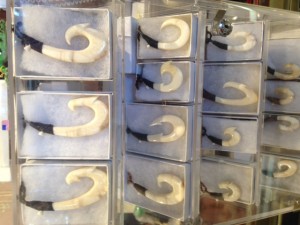Context:
I was once again wandering the streets and perusing the shops on Front St in Lahaina, HI with my mother. I was looking at some fishhooks that were carved from bone when the shopkeeper came to me. We got to talking, and I told her that I had heard of one possible origin to the practice of wearing fishhooks, when she offered up another reason for the practice, and told me the legend, the myth, of how the Hawaiian Islands came to be.
Myth:
Maui, a demigod, was out fishing one day with his brothers. They paddled far beyond their usual fishing grounds. Maui then flung his fishhook, one that was similar to these [see picture above for a decorative example] that he had carved from bone. When he got a bite, he instructed his brothers, who were earthly, to paddle as hard as they could but not to look back behind them. His brothers, who were jealous of Maui’s status as a demigod, turned around and saw that Maui was pulling up, not a fish, but land out of the sea. As soon as they looked, they were amazed, and they stooped paddling. Because they stopped paddling, the land stopped rising out of the sea, so instead of getting a great continent, all Maui got was a small chain of islands in the Pacific. Maui was furious at his brothers, as he wanted a great continent. Thus the Hawaiian Islands came to be.
Analysis:
This myth reveals several things about the Hawaiian people. First is that they are a fishing people. They rely on the sea, and thus their fishhooks are incredibly important. Second is the fact that the fishhook is made from bone. Bone, especially whalebone, was considered to be able to become an extremely lucky fishhook. Also, Maui is not just a Hawaiian mythical figure. He features in myths and legends from New Zealand – such as the legend that tells of how New Zealand’s terrain formed; why it is so hilly – and from other areas of Oceania. This can be key in discovering the migration patterns of people into Oceania – how the ancient peoples spread from mainland Asia and Australia into such far-flung and isolated island chains in the middle of a vast body of water. By tracking where similar mythological and legendary figures crop up, such as the demigod Maui, anthropologists and archaeologists can track migration patterns and possible origins for the people of these far-flung and isolated Pacific Ocean Island chains. Furthermore, this myth demonstrates how central to the Hawaiian culture fishhooks are/were. The tourism industry presumably caught wind of this importance and began to make “authentic” Hawaiian fishhooks to be worn as ornamentation and sold as “traditional” Hawaiian jewelry/ornamentation, despite fishhooks never being worn by the Hawaiian people. Nowadays, practically every gift store, souvenir shop in the islands sells fishhooks, and it has become “traditional folk” jewelry.

